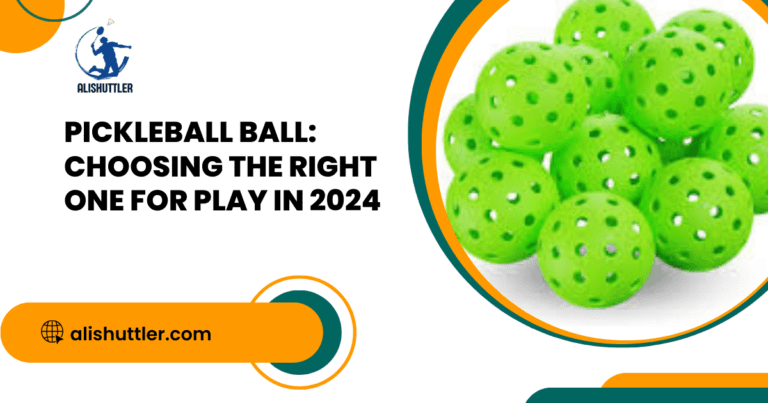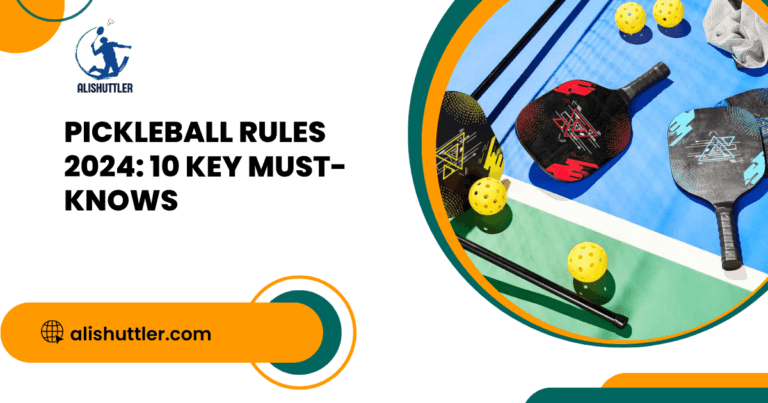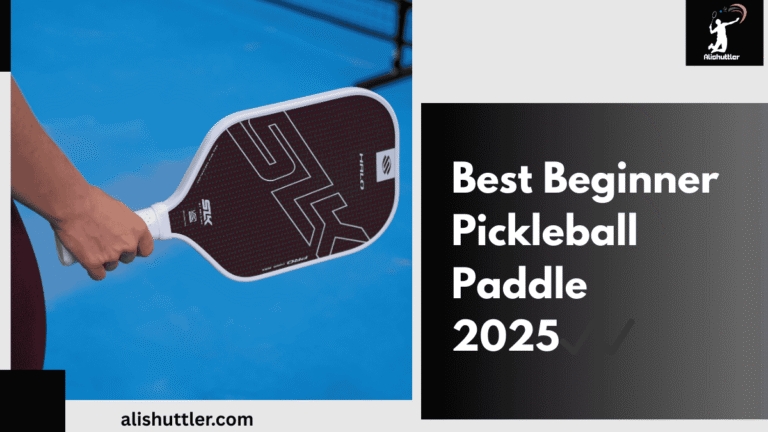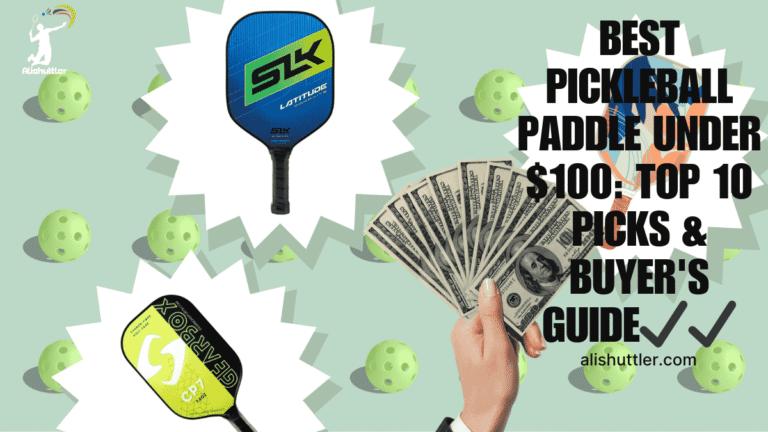This A–Z pickleball dictionary covers essential pickleball terms, slang, and strategies, combining rules, techniques, and equipment used in this dynamic sport blending tennis, badminton, and table tennis. Terms are sourced from authoritative pickleball resources, including USA Pickleball and community glossaries, for accuracy. Some letters (e.g., Q, W, X, Y) have fewer standard terms due to the sport’s specific vocabulary, but new slang may emerge as pickleball grows.
A
- Ace: A serve so well-placed the receiver fails to touch it, scoring a point (e.g., a fast serve landing deep in the service court).
- Approach Shot: A shot hit while moving toward the net, often to transition from the baseline to the non-volley zone.
- Around the Post (ATP): A legal shot hit around (not over) the net post, typically when the ball bounces wide, exploiting angles to land in the opponent’s court.
- Attackable Ball: A weak, often high shot (e.g., a lofty dink) that can be aggressively smashed or driven.

B
- Backcourt: The area near the baseline, a few feet inside the back line, used for serves or defensive positioning.
- Backhand: A shot hit with the paddle across the body, on the opposite side of the dominant hand (e.g., a right-handed player’s backhand uses the left paddle side).
- Backspin (Slice/Chop): Spin applied by striking the ball from high to low, causing it to spin opposite its flight path, often skidding low after bouncing.
- Backswing: The paddle’s backward motion from the ready position before the forward swing to hit the ball.
- Banger: A player who favors powerful, aggressive drives or smashes over finesse shots like dinks.
- Baseline: The back boundary line of the court, 22 feet from the net, marking the serving and defensive zone.
- Bert: An advanced shot where a player leaps over the kitchen’s corner on their partner’s side to volley the ball midair, landing outside the sideline.
- Body Bag (Tag): A legal shot hitting an opponent’s body, scoring a point for the hitter, often intentional to force an error.
- Bounce It: A call to a partner to let a ball bounce, typically when it’s believed to land out of bounds.
C
- Carry: An illegal shot where the ball “rides” the paddle during the swing, imparting spin or altering trajectory, often resulting in a fault.
- Center Line: The line from the non-volley zone to the baseline, dividing each side into two equal service courts.
- Champion Shot: A lucky shot that bounces twice in the non-volley zone or hits multiple surfaces (e.g., net and body), scoring a point.
- Chop: A slice shot hit from high to low, applying backspin to keep the ball low or unpredictable after bouncing.
- Continental Grip: A versatile grip where the index finger and thumb form a “V” on the paddle handle, used for serves, volleys, and dinks.
- Cookie: Slang for an easy, enjoyable shot that scores a point or sets up a rally, often used playfully.
- Crosscourt: A shot hit diagonally across the net to the opponent’s opposite court area, often for strategic placement.
D
- Dead Ball: A ball ruled out of play after a fault or dead call, ending the rally.
- Dead Dink: A weak dink shot, often too high or easily attackable, allowing opponents to counter aggressively.
- Deep: A shot landing near the opponent’s baseline, pushing them back defensively.
- Dillball: A live ball that lands inbounds and bounces once, ready for return.
- Dink: A soft, arced shot landing in the opponent’s non-volley zone (kitchen), designed to be unattackable and slow the rally.
- Distraction: Physical actions (e.g., waving arms) that interfere with an opponent’s focus, considered a fault.
- Double Bounce: A fault when the ball bounces twice on one side before being returned, resulting in a lost point.
- Double Bounce Rule (Two Bounce Rule): A rule requiring the ball to bounce once on each side (serve and return) before volleys are allowed.
- Double Hit: A single player hitting the ball twice in one continuous motion, legal if unintentional but a fault if deliberate.
- Down the Line: A shot traveling parallel to the sideline, aimed to keep opponents defensive.
- Drive: A powerful, low forehand shot aimed deep into the opponent’s backcourt to create scoring opportunities.
- Drop Shot: A soft shot from the baseline or midcourt landing in or just beyond the opponent’s kitchen, allowing the hitter to approach the net.
- Drop Shot Volley: A volley that slows the ball’s speed, landing short near the net, effective against backcourt opponents.
- Drop Spin: An advanced, chopped shot that drops sharply after crossing the net, difficult to return due to spin.
- DUPR: Dynamic Universal Pickleball Rating, an app-based system for tracking player skill levels.
E
- Erne: An advanced shot where a player leaps over the kitchen’s corner (out of bounds) to volley the ball midair, creating a powerful attack near the net. (See also Bert for partner-side variation.)
- Eye!: A warning shouted when a ball heads toward another court, alerting nearby players.
F
- Face: The paddle’s broad hitting surface, typically made of graphite, composite, or wood.
- Falafel: A weak shot with poor contact, lacking power, often called a “dead paddle” shot.
- Fault: Any rule violation (e.g., hitting out of bounds, into the net, or stepping into the kitchen while volleying) that ends the rally.
- Flick Shot: A quick, downward paddle flick near the net, landing just inside the kitchen with speed.
- Flapjack (Flabjack): A shot during the first two shots (serve or return) that must bounce once per the double bounce rule.
- Flat Face: Holding the paddle parallel to the net for a controlled, spin-free shot.
- Foot Fault: A fault from incorrect foot placement, such as stepping over the baseline during a serve or into the kitchen while volleying.
G
- Game: A series of points until one team reaches 11 (or 15/21 in some tournaments), winning by at least 2 points.
- Getting Pickled: Losing a game without scoring, resulting in an 0-11 defeat.
- Golden Pickle (Golden Ticket): An 11-0 shutout victory without side outs, where the same server completes the game, or a winning match point in a tournament.
- Graphite: A lightweight, durable paddle-face material, also called carbon fiber.
- Grip: The paddle handle’s material or the way a player holds it (e.g., continental grip).
- Groundstroke: A shot hit after the ball bounces once, as opposed to a volley.
H
- Half-Volley: A groundstroke where the paddle contacts the ball immediately after its bounce, while still low.
- Head: The paddle’s hitting surface above the handle, including the face and edge.
- Hinder: Any external interference (e.g., a stray ball) that disrupts play, potentially causing a replay.
- Hold the Line: A strategy to stay near the baseline during serves or defensive play to cover deep shots.
I
- IBP (Iffy at Best Prayer): A desperate shot with low success odds, often a last-ditch effort to keep the ball in play.
- Indoor Ball: A pickleball with 26 holes, lighter for indoor play with reduced wind resistance.
- Inside Out: A shot curving away from the body or sideline, often deceptive and aimed crosscourt.
J
- Jam (Jammed Up): A shot aimed at an opponent’s body, forcing a weak return due to limited swing space.
- Jump Smash: A powerful overhead shot hit while airborne, similar to a tennis smash, aimed to end the rally.
- Junior: A player aged 7 to 19, with dedicated programs by USA Pickleball since 2016.
K
- Kamikaze: Aggressively charging the non-volley line while the opponent hits, aiming to intercept quickly.
- Kitchen (Non-Volley Zone): The 7-foot by 20-foot area near the net where volleying is prohibited.
- Kitchen Line: The boundary line of the non-volley zone, stretching across the court.
- Knuckleball: A shot with minimal spin, creating an unpredictable bounce or trajectory.
L
- Let: A serve hitting the net but landing in the correct service court, replayed without penalty.
- Line Call: A verbal judgment of whether a ball lands “in” or “out,” with each side responsible for their own calls.
- Lines: Court boundary lines, considered “in” except for the kitchen line during volleys.
- Live Ball: The ball in active play, from serve until a fault or dead ball is called.
- Lob: A high, arced shot aimed deep over opponents, often called a “lobster,” to push them back.
M
- Match: Typically best 2 of 3 games, usually to 11 points, won by at least 2.
- Middle: A shot down the center line to exploit confusion in doubles play.
- Midcourt (Transition Zone): The area between the kitchen and baseline, challenging to defend.
- Mixed Doubles: Teams with one male and one female player.
- MLP: Major League Pickleball, a professional league focusing on team points.
- Momentum: A player’s forward motion after a shot, legally carrying them into the kitchen if no volley is hit.
N
- Nasty Nelson: A controversial serve intentionally hitting the non-receiving opponent, scoring a point if it hits before touching the ground.
- Net Cord: The tape or cord at the top of the net, sometimes affecting a shot’s trajectory.
- Net Height: The net measures 36 inches at the ends and 34 inches at the center, with posts 22 feet apart.
- No-Man’s Land: The midcourt area between the kitchen and baseline, a vulnerable position.
- Non-Volley Zone (NVZ): The 7-foot by 20-foot kitchen area where volleying is illegal.
- Nutmeg (5-Hole): A tricky shot hit through an opponent’s legs, surprising and hard to return.
O
- OPA!: A shout signaling open volleying after the third shot, when the double bounce rule is satisfied.
- Open Face: Holding the paddle tilted upward, often for lobs or defensive shots.
- Out: A ball landing outside court boundaries, often signaled to warn partners.
- Outdoor Ball: A pickleball with 40 holes, designed for outdoor play to withstand wind.
- Overhead: A powerful, downward shot, similar to a tennis smash, often a putaway.
P
- Paddle: The solid, short-handled equipment (not a “racket”) used to hit the ball, made of wood, composite, or graphite.
- Passing Shot: A volley or groundstroke aimed beyond an opponent’s reach to prevent a return.
- Pickled: Losing a game 11-0 without scoring, also called “getting pickled.”
- Pickledome: The championship court at major tournaments, often with spectators.
- Pickler: An enthusiastic pickleball player, often used affectionately.
- Poach: In doubles, intercepting a ball meant for the partner, typically near the kitchen to speed up play.
- PPA: Professional Pickleball Association, overseeing the PPA Tour for individual rankings.
- Putaway: An aggressive shot, like a smash or drive, that ends the rally.
Q
- Quick Hands: Fast reflexes at the net, allowing rapid volleys or reactions to fast shots.
R
- Rack: Paddles placed in rows of four at public courts to organize turn-taking.
- Rally: Continuous shot exchange from serve to fault.
- Ranking: A player’s skill level (2.0 beginner to 5.0 pro), used for tournament seeding.
- Ready Position: Knees bent, paddle up, anticipating the next shot.
- Regulation Paddle Size: Combined length and width not exceeding 24 inches, with length up to 17 inches.
- Regulation Pickleball Court: A 20-foot by 44-foot court for all play types.
- Reset: A defensive shot, often a dink, to neutralize an opponent’s attack.
- Return: A shot hit back after a serve or during a rally.

S
- Sandbagging: Registering for a tournament below one’s skill level for an unfair advantage, considered unethical.
- Scoring: Sideout scoring where only the serving team scores, announced as “server score – receiver score – server number” (e.g., “7-2-2”).
- Scorpion: A shot hit from a squatting position, with one hand popping up like a stinger to strike the ball.
- Serve: An underhand shot starting a rally, hit behind the baseline diagonally.
- Shake-N-Bake: A doubles play where one player drives the third shot diagonally, and the partner rushes the net for a volley.
- Side Out: Loss of serve, transferring it to the opponents.
- Singles: A game with one player per side, totaling two players.
- Skinny Singles: Singles play using half the court, often diagonally for practice.
- Smash: A powerful, downward overhead shot, often difficult to return.
- Stacking: A doubles strategy positioning players strategically before the serve for advantageous court sides.
- Switching: In doubles, swapping positions strategically, often signaled by hand gestures.
T
- Third Shot (Third-Shot Drop/Drive): The critical shot after the serve and return, often a soft drop into the kitchen or a hard drive to set up net play.
- Transition Zone: The midcourt area between the kitchen and baseline, tactically challenging.
U
- Unattackable Ball: A low shot (e.g., a well-placed dink) too difficult to smash, forcing a defensive response like a reset.
- USA Pickleball (USAPA): The national governing body overseeing rules, equipment, and tournaments.
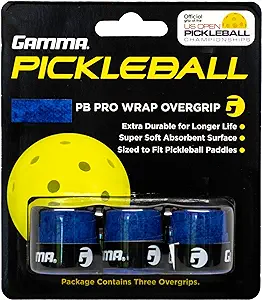
V
- Volley: Hitting the ball before it bounces, prohibited in the non-volley zone.
- Volley Llama: An illegal volley in the kitchen, resulting in a fault.
W
- Wheelhouse: The paddle’s optimal contact zone for maximum power and control.
- Wipe: A shot brushing the paddle with heavy spin, creating a sharp angle or unpredictable bounce.
X
- X-Out: A player eliminated from a tournament, often marked on brackets.
Y
- Yank: An aggressive shot pulled sharply crosscourt, often surprising opponents.
Z
- Zero-Zero-Start (Zero-Zero-Two): The starting score in doubles, announced as “0-0-2” (server #2 begins).
Why Learn Pickleball Terms from Pickleball Dictionary
Mastering this vocabulary enhances gameplay, communication with partners, and enjoyment of pickleball’s social and competitive elements. Whether avoiding a “Volley Llama” or aiming for a “Golden Pickle,” this dictionary equips players to navigate the court confidently.


